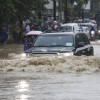Record heat across Asia is putting its surging renewable power fleet to the test, highlighting the need for backup supply, transmission system upgrades and tariff reforms to ensure reliability and stave off a slowdown in green energy adoption.
Temperatures in parts of the region breached 40 Celsius (104 Fahrenheit) in late April, earlier than usual, causing widespread infrastructure damage and power outages.
In China, where renewables account for more than half of the power mix, authorities kept backup coal and gas-fired plants on standby to meet demand and sudden spikes in consumption from the early heat, consultancy Rystad said.
India’s top solar power producing state Rajasthan has been getting “early warnings” of technical challenges that could arise as the use of renewables increases, a federal power ministry official said.
Improving reliability of the grid would involve expensive upgrades. Transmission and distribution network improvements alone are likely to cost at least $2 trillion over the next decade in the Asia-Pacific region, consultancy Wood Mackenzie predicted this month.
India is extending the life of coal-fired power plants and China is building new ones to ensure there is enough backup supply to address higher power demand, potentially increasing emissions in the absence of regulations and policy reforms.
“Heat waves are kind of the start of a vicious cycle downwards. You’re creating climate change, and then you’re causing more demand for energy, and then it’s creating more climate change,” Malavika Bambawale, APAC managing director at Engie’s sustainability division Engie Impact said.
Lack of incentives
The absence of tariff structures in much of Asia to encourage running coal or gas-based power plants for only a few peak hours a day could push grid operators to operate fossil fuel plants as much as possible, said Lauri Myllyvirta, lead analyst at the Centre for Research on Clean Energy and Air.
Power from solar and wind is harder to forecast and control as it varies by local weather conditions, and cannot be ramped up or down in response to sudden demand spurts or dips – unlike with hydro and gas.
“If proper tariff structures incentivising flexible thermal generation are not introduced, it could result in slower renewable energy adoption,” he said. “Grid regulators need to build a grid that can regulate voltage and frequency given how solar behaves. That’s of course a challenge.”
China and India are examining ways to incentivise flexible generation, but no comprehensive policy has been implemented yet.
Solar, plus coal
Green energy capacity in Asia grew 12% in 2022, the fastest rate among major regions, according to the International Renewable Energy Agency.
The share of renewables including hydro in Asia’s power mix is set to double from 2011 levels to 28% this year, Wood Mackenzie predicts. Much of that growth has come from wind and solar, which combined will account for 14% of the total, from 1% in 2011.
However, authorities in India’s sun-drenched Rajasthan state are finding it increasingly difficult to control voltage fluctuations due to the inconsistent nature of solar power output.
“When there is a fault in the grid, renewables have to stay connected and support the grid, and nearby generation resources should contribute some power to feed that fault,” the Indian official said, declining to be named as he was not authorized to speak with media.
“Many of these renewable plants are not actually able to comply with such requirements,” the official said.
To meet surging recent demand, India has increased local coal production and boosted inventories to the highest levels since the pandemic and extended an emergency mandate that forces power plants running on imported coal to maximize output.
In China, the surging share of renewables necessitates “more flexible and fast-response power sources such as gas, pumped storage and battery storage will be needed for peak shaving,” Rystad said in a note.
Cautionary tale
As many parts of Asia including China, Malaysia, India, Pakistan and Bangladesh have faced power outages in recent weeks due to extreme heat, Vietnam offers a cautionary tale.
More than half of the Southeast Asian country’s installed capacity became unavailable during a recent heatwave, causing blackouts due to low water levels at dams producing hydropower and a failure to fully integrate newly-installed solar capacity.
Part of the problem in Vietnam is that solar farms were built far from where the power was most needed, said Pablo Hevia-Koch, head of renewable integration at the International Energy Agency.
“When there’s a mismatch in where the generation is put and where the demand is, that will put some stress into the system,” Hevia-Koch said.
- Reduce Hair Loss with PURA D’OR Gold Label Shampoo
- Castor Oil Has Made a “Huge” Difference With Hair and Brow Growth
- Excessive hair loss in men: Signs of illness that cannot be subjective
- Dịch Vụ SEO Website ở Los Angeles, CA: đưa trang web doanh nghiệp bạn lên top Google
- Nails Salon Sierra Madre
 VnExpress News The News Gateway of Vietnam
VnExpress News The News Gateway of Vietnam





